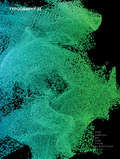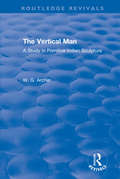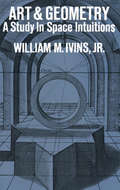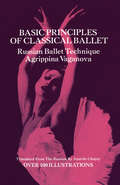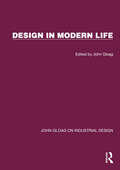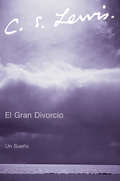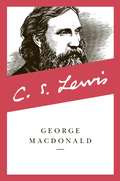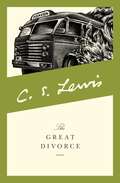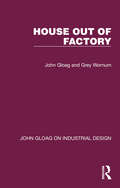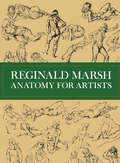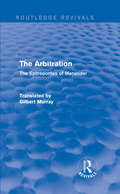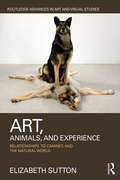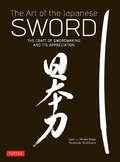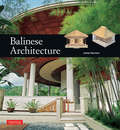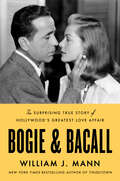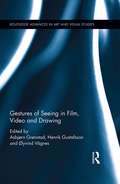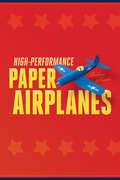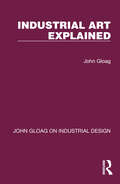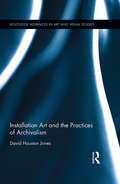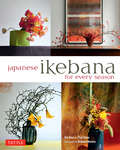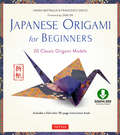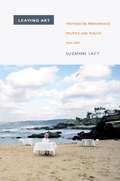- Table View
- List View
Typography 33
by Type Directors ClubFor over fifty years, the Type Directors Club has encouraged the worldwide graphic arts community to achieve excellence in typography through its annual international competitions. Typography 33 is the only annual devoted exclusively to typography and presents the finest work in the field for the year 2011. Selected from approximately 2300 international submissions to the annual Type Directors Club competition, the winning designs are models of excellence and innovation in the use of type design, representing a wide range of categories including books, magazines, corporate identities, logos, stationery, annual reports, video and web graphics, and posters.
The Vertical Man: A Study in Primitive Indian Sculpture (Routledge Revivals)
by W.G. ArcherOriginally published in 1947, The Vertical Man explores a form of Indian sculpture largely ignored in other studies, with a focus on two kinds of sculpture from the province of Bihar. The book provides detailed analysis of the formal characteristics of the sculpture and the influences of the myth, ritual, and context in which they were commissioned and made. It explains why the sculpture is regional and "why the styles are what they are". It is an original study which throws light on important subjects such as the relations of art and religion and of art and economics. The Vertical Man will appeal to those with an interest in art, specifically sculpture and the art of the Indian countryside.
Art and Geometry: A Study in Space Intuitions
by William M. IvinsOne of Western civilization's jealously guarded myths is that of Greek cultural supremacy. In this controversial study, William Ivins shows that the limitations of the Greek worldview actually hampered the development of the arts and sciences and gives a stimulating history of the new ideas of the Renaissance, especially in painting and geometry, that freed us from ancient misconceptions. Beginning with the Greeks, the author explains for the general reader the differences between ancient and Renaissance painting and sculpture, proving that the curiously static quality of Greek art arose from a misunderstanding of the laws of perspective. He then shows how this misunderstanding was corrected by Alberti, Pelerin, Durer, and other Renaissance artists who provided the first fruitful investigations of perspective. From there to projective geometry was but a step, and the author covers this major advance in our knowledge through the work of Nicholas of Cusa, Kepler, and Desargues. This book is perhaps the only concise history in English of the development of mathematical perspective and projective geometry. But the author's ability to relate styles in art to advances in geometry and his ingenious theory of the modern "visual" worldview and the Greek "tactile" worldview mean that his book will be provocative not only to mathematical historians but also to art historians and to anyone concerned with the history of thought, from philosopher to layman.
Basic Principles of Classical Ballet
by Agrippina VaganovaAlthough the stars of Russian ballet Anna Pavlova and Tamara Karsavina possessed a national manner of dancing, there was no truly Russian school of dancing until the 1930s. The development of this school was largely due to Mme. Vaganova (1879-1951), not only a great dancer but also the teacher of Galina Ulanova and many others and an unsurpassed theoretician.The principles of Vaganova's system are presented in this well-known book. Mme. Vaganova's aim of creating a personal approach to the Russian dance was based on the critical assimilation of the experience of her contemporaries. Her ability to choose the best of what had been accomplished in the various ballet traditions (French, Italian, and Russian) and combine these into a unified teaching practice in itself amounted to a new school of dance. She firmly believed that the teaching process should be a planned exercise, ever changing with innovations in the dance. She sought from her pupils emotional expressiveness, strictness of form, a resolute, energetic manner of performance, and the understanding of the underlying coordination of movements.Her book discusses all basic principles of ballet, grouping movements by fundamental types. Chapters cover battements, rotary movements of the legs, the arms, poses of the classical dance, connecting and auxiliary movements, jumps, beats, point work, and turns as well as material for a sample lesson. Diagrams show clearly the exact foot, leg, arm, and body positions for the proper execution of many steps and movements. The result is a fundamental theory of dance that offers dancers, teachers, and ballet lovers information often difficult to locate in other books. 118 illustrations.
Design in Modern Life (John Gloag On Industrial Design Ser.)
by John GloagOriginally published in 1946, this book is based on a series of broadcast talks on design. Led by an engineer, an artist and critic of architecture and industrial design, the discussions focussed on the problems that were involved by a general application of design to the environment of contemporary life. It surveys the possibilities of design in modern life and the talks have been rewritten, amplified and revised for the purposes of the book.
El Gran Divorcio: Un Sueno
by C. S. LewisUn fantástico viaje entre el Cielo y el InfiernoEn El Gran Divorcio, C. S. Lewis de nuevo utiliza su formidable talento para contar fábulas y alegorías. En un sueño, el escritor se sube a un autobús una tarde lloviznosa y se embarca en un increíble viaje por el Cielo y el Infierno. Este es el punto de partida para la profunda meditación sobre el bien y el mal."Si insistimos en quedarnos con el Infierno (o incluso la Tierra) no veremos el Cielo: si aceptamos al Cielo no podremos quedarnos ni siquiera con el más pequeño e íntimo souvenir del Infierno."
George MacDonald (Collected Letters Of C. S. Lewis Ser.)
by C. S. LewisIn this collection selected by C. S. Lewis are 365 selections from MacDonald's inspiring and challenging writings.
Grassroots Baseball: Route 66
by Jean Fruth Jeff Idelson Jim ThomeJust as baseball is at the heart of America, so too is Route 66. This book is a photographic tribute to the national pastime along the artery that stretches from the shores of Lake Michigan, close to where the Cubs play, to the Pacific Ocean at Santa Monica, where baseball memories and players abound. Among the players who will guide readers on the journey will be baseball greats George Brett, Billy Hatcher, Alex Bregman, and Ryan Howard. Leading off will be Johnny Bench of Binger, Oklahoma, and cleaning up will be Jim Thome of Peoria, Illinois.In Grassroots Baseball: Route 66, photographer Jean Fruth weaves more than 250 full-color images of the national pastime along the historic highway into a tapestry that reminds us of the heart and soul of America.Route 66 passes through eight states in its journey to the Pacific, and each chapter opens with a first-person essay by a baseball legend from that locale recounting his early memories of playing the game, and what it was like growing up along the Mother Road. That highway took stars like George Brett, Billy Hatcher, Alex Bregman, Adam LaRoche, and Ryan Howard to faraway places they only dreamed about as kids.Each chapter documents the route they took, from sandlots, ranches, and beaches to ballparks at every level of organized baseball, from Little League games to the World Series. With an introduction by Johnny Bench, a foreword by Mike Veeck, a preface by retired Hall of Fame President Jeff Idelson, and an afterword by Jim Thome, this book touches all the bases for any and every baseball fan.
The Great Divorce (C. S. Lewis Signature Classic Ser.)
by C. S. LewisC. S. Lewis takes us on a profound journey through both heaven and hell in this engaging allegorical tale. Using his extraordinary descriptive powers, Lewis introduces us to supernatural beings who will change the way we think about good and evil.
House Out of Factory (John Gloag On Industrial Design Ser.)
by John Gloag Grey WornumOriginally published in 1946, when Britain was facing a post-war housing crisis, this book dealt with the issue of the factory-produced house in being part of the solution for housing people in an affordable manner and a short time-scale. The book, aimed at both lay-people and technicians discusses aspects of pre-fabricated housing such as comfort, standardisation and aesthetics. The book is illustrated with 48pp of black and white plates.
Anatomy for Artists (Dover Anatomy for Artists)
by Reginald MarshPortraying the living human form, not only with anatomical accuracy, but so that it conveys motion, emotion, and vitality is one of the greatest challenges faced by the artist. In the studies in this volume, famous artist and art instructor Reginald Marsh brought his genius to bear on the complex problem of life drawing. Delving into the work of the great masters (Michelangelo, Leonardo, Raphael, Rubens, Poussin, Dürer, Holbein, and others), Marsh simplified, abstracted, adapted, and reinterpreted their work into a collection of drawings both immensely interesting and instructive to the practicing artist and the student. The 209 pages of drawings in this volume show the human body in a wide variety of positions, viewed from many different angles. Marsh directs special attention to those angles, aspects, and physical positions which are the most difficult to portray. His great talent, coupled with a rare ability to instruct others (Marsh taught at the Art Students League for many years) gave him unusual sensitivity to the concerns of the artist in life drawing: his concise commentary on the drawing points up the problems addressed in each -- tone, movement, proportion, composition, etc. The front, side, back, head, arms and hands, legs and feet, and full figure drawings are all included. A separate section on the problems of proportion explores 7, 7 1/2, and 8 head schemes, providing an unusually workable and lucid treatment of the topic for the practicing artist. The body and parts of the body are drawn in skeleton, tissue and muscle, major bone structure, and as they appear in life. Marsh studied medical anatomy as well as the work of the great medical artists in order to perfect his knowledge of human anatomy. All of the hundreds of drawings, figures, and details of this volume have been excellently reproduced in this edition. The last 95 drawings in the book are all original studies by Marsh, never before published in book form. These casual, light-hearted drawings (mostly of female nudes) illustrate both Marsh's seemingly easy mastery of the techniques of life drawing, and his characteristic lusty, Rubenesque style. Because they are so distinctly in his own style, these drawings highlight the great scope and knowledgeability he has shown in the earlier instructive studies. Those who know and admire Marsh as an artist, as well as anyone who wishes to learn to draw from life, will find this volume indispensable.
The Arbitration: The Epitrepontes of Menander (Routledge Revivals)
by Gilbert MurrayGilbert Murray translated and made available to modern readers The Epitrepontes of Menander or The Arbitration for the first time in 1945. The Arbitration is among the most frequently quoted and most famous of Menander’s plays and – being less farcical than others - belongs to his mature style. With an interesting and informative introduction, this translation will be of value to any student of Classics and Ancient Greek drama.
Art, Animals, and Experience: Relationships to Canines and the Natural World (Routledge Advances in Art and Visual Studies)
by Elizabeth SuttonElizabeth Sutton, using a phenomenological approach, investigates how animals in art invite viewers to contemplate human relationships to the natural world. Using Rembrandt van Rijn’s etching of The Presentation in the Temple (c. 1640), Joseph Beuys’s social sculpture I Like America and America Likes Me (1974), archaic rock paintings at Horseshoe Canyon, Canyonlands National Park, and examples from contemporary art, this book demonstrates how artists across time and cultures employed animals to draw attention to the sensory experience of the composition and reflect upon the shared sensory awareness of the world.
The Art of the Japanese Sword
by Yoshindo Yoshihara Hiroko Kapp Leon KappIn The Art of the Japanese Sword, master swordsmith Yoshindo Yoshihara offers a comprehensive view on the making, finishing and appreciation of Japanese blades.The Japanese sword, a unique work of art in steel, can be appreciated from a number of viewpoints. Its functionality as a weapon, the sophisticated metallurgy and scientific thinking utilized by the swordsmith, the shape of the blade itself, and the different crystalline forms in the steel all contribute to the beauty of these remarkable weapons. The Art of the Japanese Sword conveys to the reader a basic background regarding the Japanese sword, as well as an explanation of how to view and appreciate a blade. It also illustrates the details of how a sword is made and finished today.Modern craftsmen use completely traditional methods from the past to prepare their steel, forge the sword and create the unique hardened edge. By gaining a good understanding of how a sword is actually made, the reader will be able to appreciate the Japanese sword more fully.
The Art of the Japanese Sword
by Yoshindo Yoshihara Hiroko Kapp Leon KappIn The Art of the Japanese Sword, master swordsmith Yoshindo Yoshihara offers a comprehensive view on the making, finishing and appreciation of Japanese blades.The Japanese sword, a unique work of art in steel, can be appreciated from a number of viewpoints. Its functionality as a weapon, the sophisticated metallurgy and scientific thinking utilized by the swordsmith, the shape of the blade itself, and the different crystalline forms in the steel all contribute to the beauty of these remarkable weapons. The Art of the Japanese Sword conveys to the reader a basic background regarding the Japanese sword, as well as an explanation of how to view and appreciate a blade. It also illustrates the details of how a sword is made and finished today.Modern craftsmen use completely traditional methods from the past to prepare their steel, forge the sword and create the unique hardened edge. By gaining a good understanding of how a sword is actually made, the reader will be able to appreciate the Japanese sword more fully.
Balinese Architecture
by Luca Invernizzi Tettoni Bruce Granquist Davison Julian Nengah Enu Mubinas HanafiBalinese style villas and resorts are popping up everywhere-from Ibiza to St Barts to Singapore. But what is Balinese architecture? And why is it so popular today?Traditional Balinese houses, temples and pavilions are designed to allow man to exist in harmony with the natural forces of the universe-reflecting core Balinese beliefs about man's place in relation to the cosmos, the gods, the ancestors, and the world around him. Innovative local and Western architects have been designing resorts and villas on Bali for decades, drawing their inspiration from these local traditions.In this one-of-a-kind book, author Julian Davison provides a comprehensive guide to Balinese architectural forms, the Balinese belief system, the rituals associated with building, the materials and construction techniques, and the intricate ornamentation used. Over 100 watercolor illustrations and photographs provide a clear picture of the island's architecture as well as an eye-opening look at a culture and a people that have captivated the world's imagination.
Bogie & Bacall: The Surprising True Story of Hollywood's Greatest Love Affair
by William J. MannFrom the noted Hollywood biographer and author of The Contender comes this celebration of the great American love story—the romance between Lauren Bacall and Humphrey Bogart—capturing its complexity, contradictions, and challenges as never before.In Bogie & Bacall, William Mann offers a deep and comprehensive look at Lauren Bacall, Humphrey Bogart, and the unlikely love they shared. Mann details their early years—Bogart’s effete upbringing in New York City; Bacall’s rise as a model and actress. He paints a vivid portrait of their courtship and twelve-year marriage: the fights, the reconciliations, the children, the affairs, Bogie’s illness and Bacall’s steadfastness until his death. He offers a sympathetic yet clear-eyed portrait of Bacall’s life after Bogie, exploring her relationships with Frank Sinatra and Jason Robards, who would become her second husband, and the identity crisis she faced.Surpassing previous biographies, Mann digs deep into the celebrities’ personal lives and considers their relationship from surprising angles. Bacall was just nineteen when she started dating the thrice-married forty-five-year-old Bogart. How might that age gap have influenced their relationship? In addition to what she gained, what might Bacall have lost by marrying a Hollywood superstar more than twice her age? How did Bogart, a man of average looks, become one of the greatest movie stars of all time? Throughout, Mann explains the unparalleled successes of their individual careers as well as the extraordinary love between them and the legend that has endured.Filled with entertaining details and thoughtful insights based on newly available records and correspondence, and illustrated with 30-40 photographs, Bogie & Bacall offers a fresh look at this famous couple, their remarkable relationship, and their legacy.
Gestures of Seeing in Film, Video and Drawing (Routledge Advances in Art and Visual Studies)
by Øyvind Vågnes Asbjørn Grønstad Henrik GustafssonThe first book of its kind, Gestures of Seeing in Film, Video and Drawing engages broadly with the often too neglected yet significant questions of gesture in visual culture. In our turbulent mediasphere where images – as lenses bearing on their own circumstances – are constantly mobilized to enact symbolic forms of warfare and where they get entangled in all kinds of cultural conflicts and controversies, a turn to the gestural life of images seems to promise a particularly pertinent avenue of intellectual inquiry. The complex gestures of the artwork remain an under-explored theoretical topos in contemporary visual culture studies. In visual art, the gestural appears to be that which intervenes between form and content, materiality and meaning. But as a conceptual force it also impinges upon the very process of seeing itself. As a critical and heuristic trope, the gestural galvanizes many of the most pertinent areas of inquiry in contemporary debates and scholarship in visual culture and related disciplines: ethics (images and their values and affects), aesthetics (from visual essentialism to transesthetics and synesthesia), ecology (iconoclastic gestures and spaces of conflict), and epistemology (questions of the archive, memory and documentation). Offering fresh perspectives on many of these areas, Gestures of Seeing in Film, Video and Drawing will be intensely awaited by readers from and across several disciplines, such as anthropology, linguistics, performance, theater, film and visual studies.
High-Performance Paper Airplanes
by Andrew DewarFold and fire aerodynamic paper airplanes dozens of feet into the air with this easy origami ebook.High Performance Paper Airplanes presents a collection of realistic origami paper airplanes from well-known author and paper aviation expert Andrew Dewar. Dewar has spent decades perfecting the art of folding easy paper airplanes that both look great and fly well. This new series takes paper airplanes to new heights-literally! The planes can be fired high into the air with a rubber band launcher and are designed to circle down for a long time. The airplane designs are also printed in full-color on both sides and precut so you just need to push them out and assemble them using a bit of glue. Although fun for folders of any age, these paper plane designs are so simple that they can be considered "origami-for-kids" projects and are a great way to learn origami.The origami airplanes range from simple designs that can be assembled in under a minute to detailed scale replicas that look and fly like the real thing. The included instructional origami book not only explains how to assemble each plane, but how to fine-tune it to coax the best performance. Helpful tips for hosting competitions with your friends, and suggestions for designing your own origami airplane models are also included.This paper airplanes ebook contains: 46 page, full-color origami book Clear step-by-step instructionsTips on building and flying paper planes 10 paper airplane models Colorful and realistic designsFun to build and amazing to fly, these beautiful models are guaranteed to turn heads and draw a crowd of spectators every time you fly them. Using the rubber-band catapult and with a bit of practice, you'll be able to launch paper planes that remain aloft for 30 to 60 seconds-and more!Paper airplane models include:Hornet Tiger Eclipse Zero Corsair And many more...
Industrial Art Explained (John Gloag On Industrial Design Ser.)
by John GloagOriginally published in 1934 this book became recognised as one of the principal standard works on industrial design and industrial architecture. The chapters explain the complete operation, character and background history of industrial art, its relation to architecture, materials, industrial production and retail distribution. It is fully illustrated with line drawings and photographs.
Installation Art and the Practices of Archivalism (Routledge Advances in Art and Visual Studies)
by David Houston JonesOn the leading edge of trauma and archival studies, this timely book engages with the recent growth in visual projects that respond to the archive, focusing in particular on installation art. It traces a line of argument from practitioners who explicitly depict the archive (Samuel Beckett, Christian Boltanski, Art & Language, Walid Raad) to those whose materials and practices are archival (Mirosław Bałka, Jean-Luc Godard, Silvia Kolbowski, Boltanski, Atom Egoyan). Jones considers in particular the widespread nostalgia for ‘archival’ media such as analogue photographs and film. He analyses the innovative strategies by which such artefacts are incorporated, examining five distinct types of archival practice: the intermedial, testimonial, personal, relational and monumentalist.
Japanese Ikebana for Every Season
by Rie Imai Yuji Ueno Noboru MurataThe true meaning of Ikebana-the traditional Japanese art of flower arrangement-is the ability to take a few beautiful flowers and plans and tastefully present them in very simple containers to decorate your home. Whether for Mother's Day, Valentine's Day, or a special birthday or anniversary-Japanese Ikebana for Every Season simplifies and demystifies this ancient art by presenting 53 elegantly simple arrangements that anyone can create at anytime at home.The key to good Ikebana arrangements is to understand a few very simple principles-like the idea of mitate-seeing old things with new eyes, as well as learning a few very easy techniques of flower stabilization and how to support plants and flowers inside a vase or container. Using simple, common flowers and plants from your garden, from a nearby field or forest, or from your local florist-you can easily create these lovely Ikebana in just a few minutes if you know how.Authors Rie Imai and Yuji Ueno explain how to select the flowers and the containers by simply using things that are already around you-and then they show you how to turn them into something special. The basic instructions in the book cover a wide range of styles that encourage readers to use their own creativity rather than copying traditional and highly technical Ikebana design concepts.No matter what time of year it is and regardless of your taste or budget-the arrangements in this book will lend a touch of Japanese elegance to your home!
Japanese Ikebana for Every Season
by Noboru Murata Yuji Ueno Rie ImaiThe true meaning of Ikebana-the traditional Japanese art of flower arrangement-is the ability to take a few beautiful flowers and plans and tastefully present them in very simple containers to decorate your home. Whether for Mother's Day, Valentine's Day, or a special birthday or anniversary-Japanese Ikebana for Every Season simplifies and demystifies this ancient art by presenting 53 elegantly simple arrangements that anyone can create at anytime at home.The key to good Ikebana arrangements is to understand a few very simple principles-like the idea of mitate-seeing old things with new eyes, as well as learning a few very easy techniques of flower stabilization and how to support plants and flowers inside a vase or container. Using simple, common flowers and plants from your garden, from a nearby field or forest, or from your local florist-you can easily create these lovely Ikebana in just a few minutes if you know how.Authors Rie Imai and Yuji Ueno explain how to select the flowers and the containers by simply using things that are already around you-and then they show you how to turn them into something special. The basic instructions in the book cover a wide range of styles that encourage readers to use their own creativity rather than copying traditional and highly technical Ikebana design concepts.No matter what time of year it is and regardless of your taste or budget-the arrangements in this book will lend a touch of Japanese elegance to your home!
Japanese Origami for Beginners Kit
by Vanda Battaglia Francesco DecioMake simple and fun paper craft models with this easy origami book and paper kit. The ancient art of origami originated in Japan, where it is steeped in traditional values. The 20 models presented in this kit include many with strong symbolic meanings, such as the carp, the frog and the crane, which symbolize longevity, good luck and perseverance. Also included in this kit are paper models which have practical uses, such as a bag in which to store spices or powdered medications, the masu box for containing small gifts, and uniquely shaped notes with elaborate closures. The more playful side of origami is represented as well: the stylized sumo wrestler with realistic moves has entertained Japanese children for centuries, and the paper Samurai hat is fun to play with. Origami is an ideal activity for children since paper folding develops dexterity and creativity. Origami is also a craft based on a few fundamental 3D folding techniques, soJapanese Origami for Beginners Kit is a useful starting point for fans of all ages and abilities. Although this book is aimed at origami beginners, it contains projects suitable for origami fans of all ages and abilities and is the perfect book for all those who enjoy making things with their hands. This book opens with an illustrated history of origami that highlights the masters and evolution of this pastime and art form up until the present day. A glossary of important origami folding symbols shows you how to follow the diagrams, which are commonly used to indicate how to fold origami models. Easy-to-follow step-by-step instructions follow for each of the 20 models. For those who prefer to see the models folded, this kit includes complete video instructions on a free DVD. It also has72 high-quality origami folding papers, all decorated with a wide selection of traditional Japanese designs and patterns. All of the folds are simple enough to be origami-for-kids projects and are a great way to learn origami. None of the projects require paint or glue; so just grab the included origami paper and start folding right away!
Leaving Art: Writings on Performance, Politics, and Publics, 1974–2007
by Suzanne Lacy Kerstin May Moira RothSince the 1970s, the performance and conceptual artist Suzanne Lacy has explored women's lives and experiences, as well as race, ethnicity, aging, economic disparities, and violence, through her pioneering community-based art. Combining aesthetics and politics, and often collaborating with other artists and community organizations, she has staged large-scale public art projects, sometimes involving hundreds of participants. Lacy has consistently written about her work: planning, describing, and analyzing it; advocating socially engaged art practices; theorizing the relationship between art and social intervention; and questioning the boundaries separating high art from popular participation. By bringing together thirty texts that Lacy has written since 1974, Leaving Art offers an intimate look at the development of feminist, conceptual, and performance art since those movements' formative years. In the introduction, the art historian Moira Roth provides a helpful overview of Lacy's art and writing, which in the afterword the cultural theorist Kerstin Mey situates in relation to contemporary public art practices.
